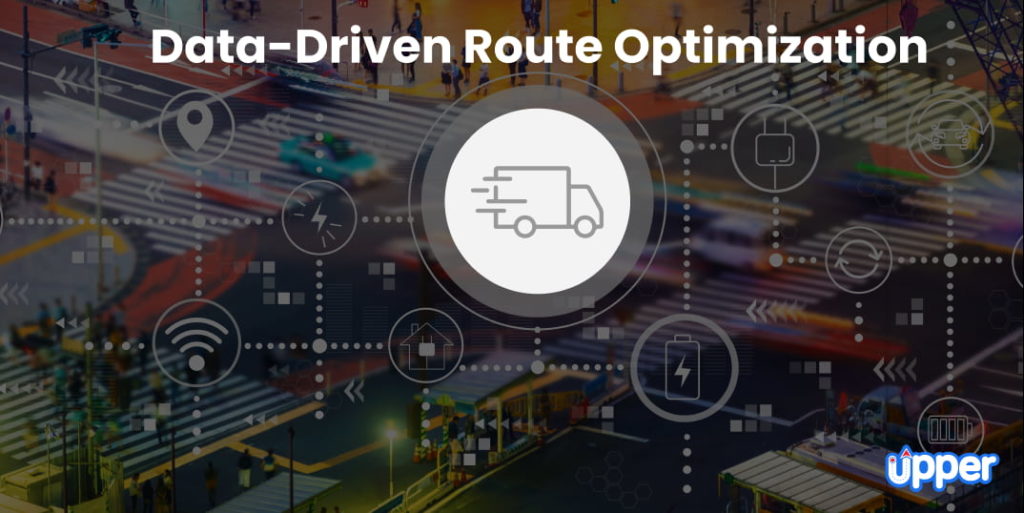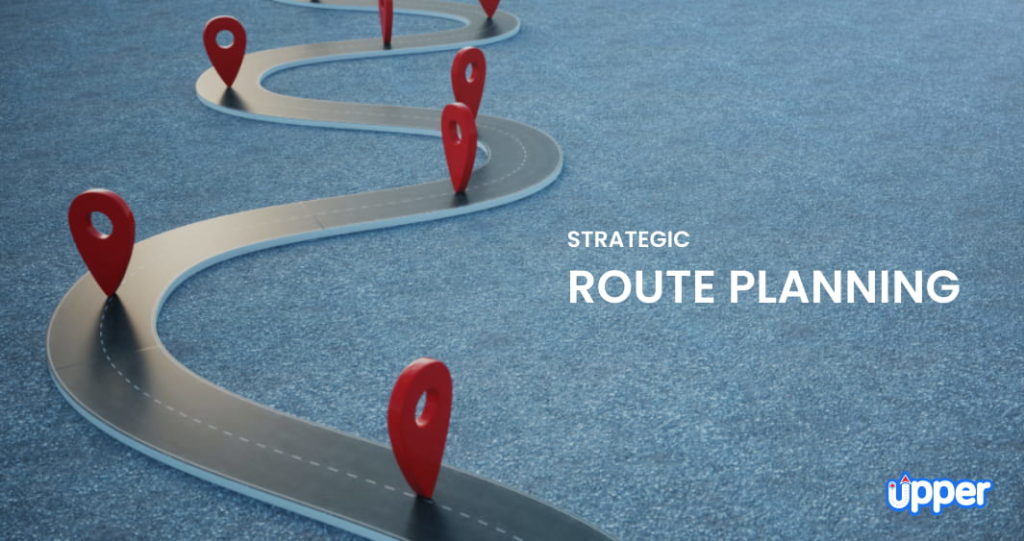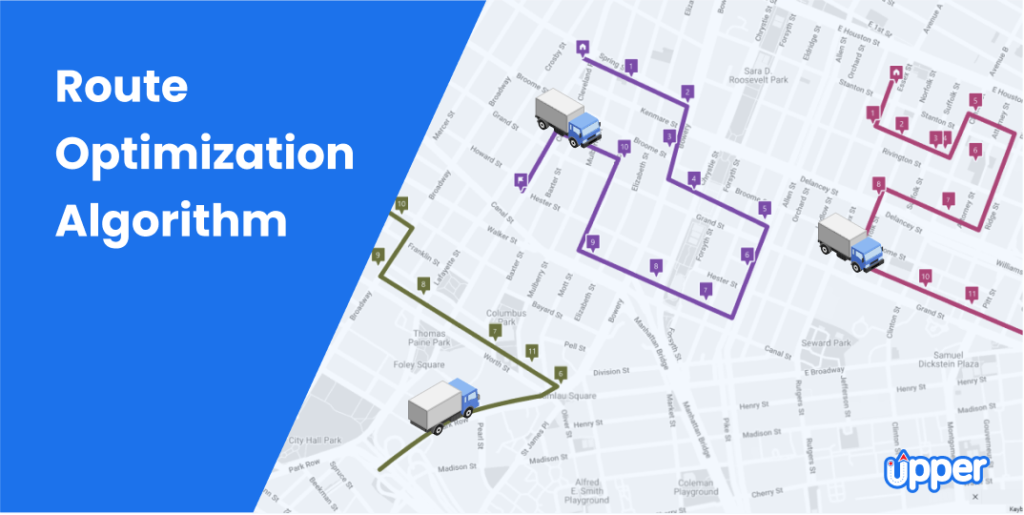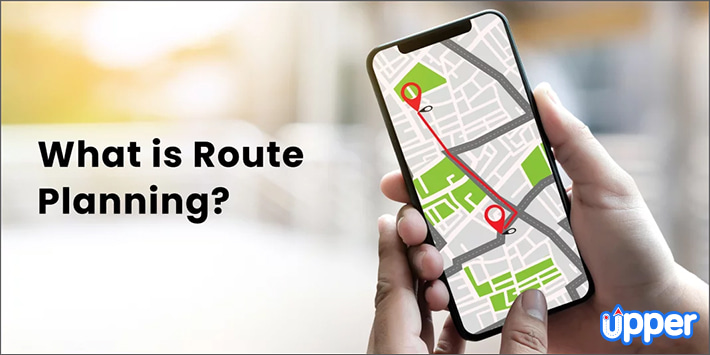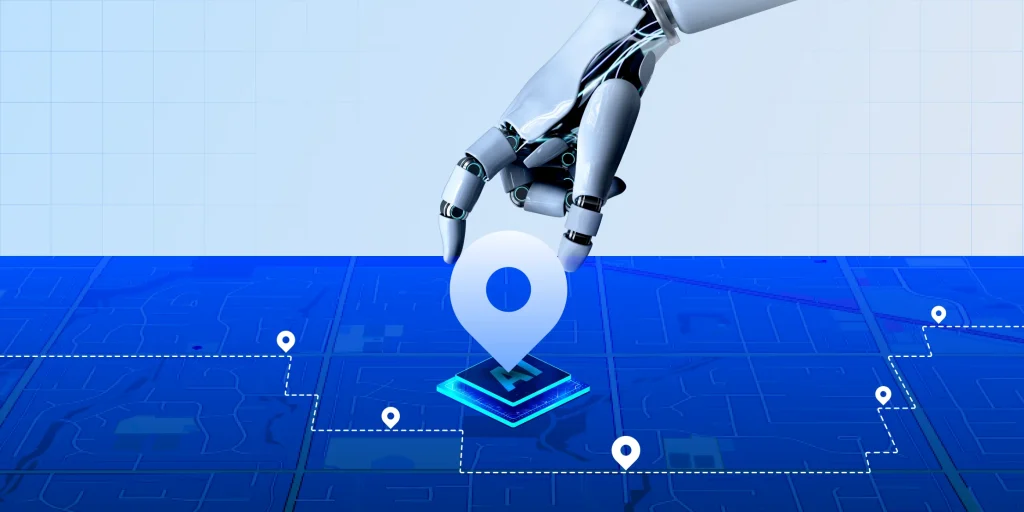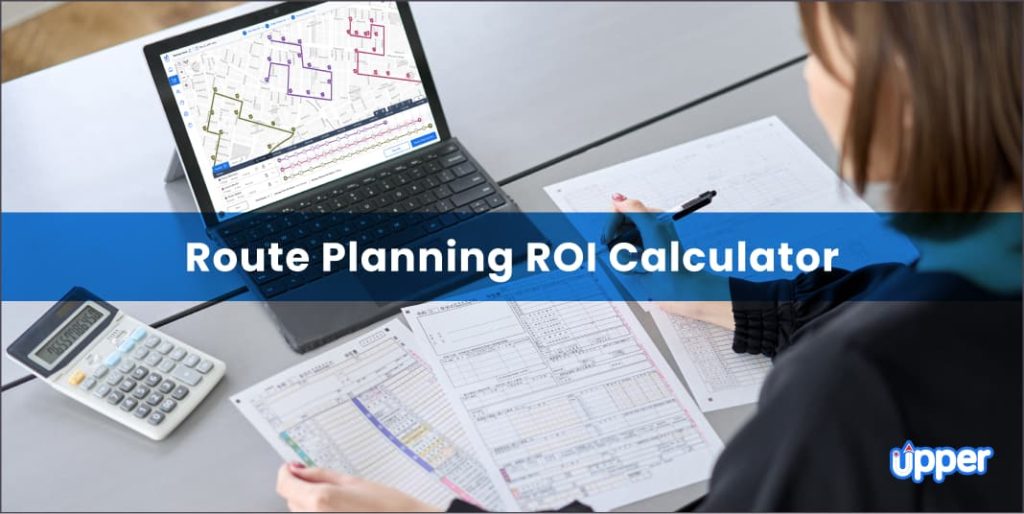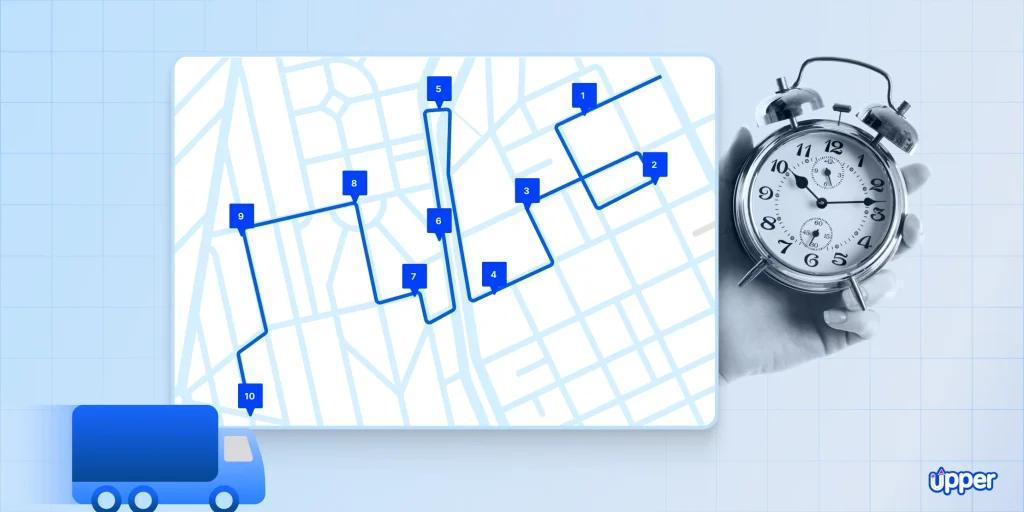 Key Takeaways:
Key Takeaways:
- Data-driven route optimization helps businesses to optimize their delivery operations by considering real-time data, historical performance, and predictive analytics.
- Routing optimization software is very important for gathering and utilizing data to improve delivery operations and make them more efficient.
- By gathering and analyzing data, businesses can anticipate future demand, detect bottlenecks, and make data-driven decisions to keep getting better.
- Data analytics and reporting give businesses useful information about the delivery history, driver performance, and customer information, which helps them improve their routes.
Did you know that data-driven businesses have a 23 times higher chance of acquiring customers, a 6 times higher probability of retaining those customers, and a 19 times higher potential of being profitable? That’s true; in today’s competitive business environment, data-driven decision-making is the key to success.
But in terms of route optimization, what exactly does it mean to be data-driven? It entails using potent route planning and optimization software that simplifies the routing process while gathering and analyzing essential data to boost delivery operations.
Imagine being able to make intelligent decisions, optimize routes on the fly, and delight your customers with prompt deliveries—all backed by real data.
So herein, we’ll discuss the concept of data-driven route optimization and cover each and every aspect of it.
Forget Spaghetti Routes, Optimize Routes for Your Entire Team with Upper
Start a 7-Day Free Trial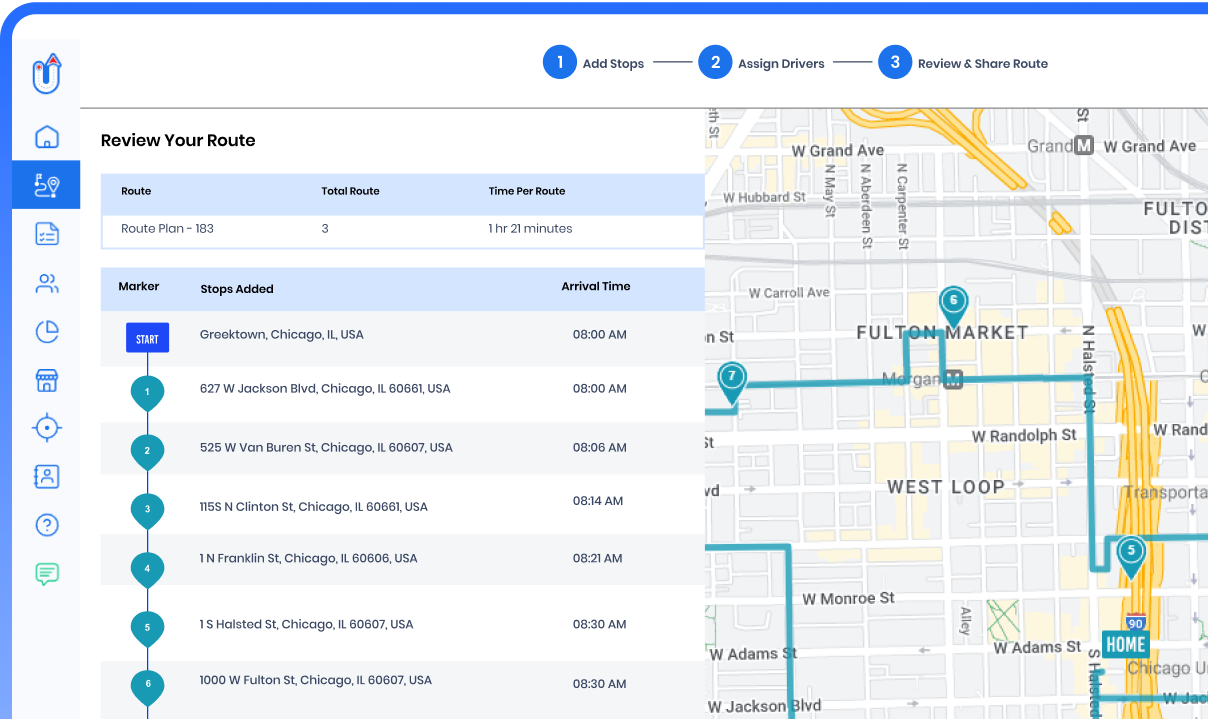
Table of Content
- Understanding Data-Driven Route Optimization
- Data Types and Implementation
- Route Optimization vs. Data-Driven Route Optimization: A Comparative Analysis
- Implementation Benefits
- What are the Challenges Faced by Companies When Implementing Data-Driven Route Optimization?
- How can Upper Help in Data-Driven Route Optimization?
- FAQs
- Conclusion
Understanding Data-Driven Route Optimization
Data-driven route optimization refers to the use of data analytics and advanced path optimizing algorithms to optimize delivery routes. This approach uses a significant amount of data, including historical data, real-time data, and predictive analytics, to determine the most efficient route for a given set of constraints or objectives.
Core Components
- Historical data: This contains information about previous routes, their effectiveness, travel duration, fuel consumption, etc. This information serves as a baseline for optimization and aids in identifying recurring patterns or issues.
- Real-time data: This includes information about live traffic updates, road conditions, weather, construction work, etc. Real-time data is useful for adjusting the route dynamically, avoiding traffic jams, and responding to unexpected events.
- Predictive analytics: This entails making predictions about potential bottlenecks, changes in route conditions, and congestion issues in the future. This predictive element can assist minimize unexpected delays and boost efficiency by adjusting routes in advance.
- Advanced algorithms: These advanced algorithms examine the data to find the most effective route. They take into account a number of variables, such as the shortest distance, the least amount of traffic, fuel efficiency, customer preferences, vehicle capacity, and time constraints. Advanced algorithms can address challenging optimization issues and swiftly identify optimal solutions.
Data-driven route optimization’s primary goals are to decrease costs (fuel, time, and labor), improve customer satisfaction (shorter delivery times, more reliability), and lessen the impact on the environment (lower CO2 emissions).
Technology Stack
1. AI Integration
Artificial intelligence (AI) forms a crucial aspect of data-driven route optimization. This makes it possible for organizations to handle and analyze massive amounts of data more correctly and quickly than they could before.
The following are some ways that AI and ML assist in data-driven route optimization:
- Pattern recognition: AI and ML systems can find trends and patterns in huge datasets using both historical and current data, enabling the optimization of routes.
- Optimization algorithms: AI-powered optimization algorithms assess multiple alternative routes while taking into account a variety of constraints and objectives to determine the most effective route.
2. Machine Learning Capabilities
- Real-time adjustments: AI and ML algorithms analyze real-time data to modify routes as they travel, taking into account variables like traffic, weather, and customer preferences.
- Predictive analysis: ML models learn from historical data to forecast future circumstances, such as traffic patterns, enabling proactive route planning and adjustments.
Route Optimization at Its Best
Upper's real-time data, predictive analytics and advanced algorithms ensures optimal routes are planned delivering better efficiency and enhanced customer satisfaction.
Data Types and Implementation
Data-driven route optimization makes decisions and optimizes routes based on various types of data. The most commonly used data is listed below:
Historical Data Analysis:
1. Historical route data:
Analyzing historical route data allows you to plan and optimize your future routes by taking into account factors like travel times, fuel consumption, and other details. Historical information sheds light on recurring patterns and helps pinpoint areas for improvement.
2. Historical performance data:
Analyzing historical performance data on delivery timeliness, customer satisfaction levels, and other pertinent indicators enables the identification of areas requiring improvement and the optimization of future performance.
Real-time data processing
1. Geospatial data:
Geographical information is crucial in figuring out the shortest or fastest routes. It includes information on road networks, the locations of start points, endpoints, and waypoints along the route, as well as geocoding data.
2. Vehicle data:
When managing a fleet, vehicle data is vital. This data pertains to vehicle size, capabilities, fuel efficiency, vehicle capacity, and speed limits. Resource allocation and load balancing efficiency are ensured through route optimization based on vehicle data.
3. Road network data:
Data on road network includes details on the different types of roads, the posted speed limits, toll roads, bridges, tunnels, and other factors. This affects the viability and usability of a route for various vehicle types.
4. Driver data:
To comply with regulations and safeguard drivers’ well-being, routing optimization takes into account driver-related data such as hours of service, skills or certifications, preferences, and performance.
5. Customer preference data:
Route planning is impacted by customer preferences, such as preferred delivery windows or service level agreements. Taking into account the preferences of customers makes them happier and more loyal.
6. Load data:
When there are several pickup or delivery locations, information about the type and quantity of product being delivered might impact route optimization. Load data ensures effective load sequencing and optimizes vehicle usage.
7. Priority levels:
Depending on the nature of the items or customer requirements, some deliveries can be given a greater priority than others. Route planning is influenced by priority levels to ensure that time-sensitive deliveries are prioritized.
8. Cost data:
When determining the most cost-effective route, it’s necessary to take into account cost-related elements including fuel costs, labor costs, tolls, and other operating costs.
9. Vehicle maintenance schedules:
Schedules for vehicle maintenance are taken into consideration in order to prevent scheduling a vehicle that won’t be available due to maintenance or repairs.
10. Regulatory restrictions:
Adherence to legal restrictions is essential. This includes road weight limits, rules for the transportation of hazardous products, and observance of driver working hours.
11. Environmental data:
Several businesses place a high priority on sustainability and minimizing the impact on the environment. For such businesses, route optimization can take into account environmental parameters such as air quality or CO2 emission levels in addition to weather conditions.
12. Real-time tracking data:
GPS and other tracking systems can offer real-time information on a vehicle’s location, allowing for quick adjustments to be made in case of any issues or unexpected events.
13. Traffic data:
To reduce delays and optimize routes, traffic information is essential. This includes historical, real-time, and predictive data on traffic flow, congestion, road closures, and accidents.
14. Time windows:
Consideration of specified delivery or pickup time windows is necessary for many logistical operations. The availability of customers, business hours, and time-sensitive requirements all affect route planning.
Predictive analytics integration
To predict future situations, such as expected traffic congestion at a specific time of day, predictive analytics approaches combine historical data, machine learning, and statistical models. Incorporating predictive analytics data enables preemptive route modifications and effective resource allocation.
1. Weather impact modeling:
Decisions on choosing a route and safety can be affected by severe weather. In order to prevent delays, manage detours, and ensure the safety of the driver and the load, real-time and forecasted weather data are useful.
2. Traffic data:
To reduce delays and optimize routes, traffic information is essential. This includes historical, real-time, and predictive data on traffic flow, congestion, road closures, and accidents.
Did you know?
By using data to optimize routes, predict demand, and dynamically alter prices, Uber upended the conventional taxi industry. Uber offers reliable and affordable transportation services by analyzing data from millions of trips.
Personalize Routes for Better Efficiency
Adjust factors such as traffic patterns, weather conditions, service times, & customer preferences to ensure that every route is efficient & tailored to your specific needs.
Route Optimization vs. Data-Driven Route Optimization: A Comparative Analysis
Let’s compare traditional route optimization with data-driven route optimization using a comparative table to help you better understand the concept:
| Aspect | Route Optimization | Data-Driven Route Optimization |
|---|---|---|
| Basis | Primarily based on distance or time. | Based on a wide range of factors and data sources. |
| Flexibility | Often static, with changes made manually. | Dynamic and capable of making adjustments in real-time. |
| Decision-Making | Relies on pre-defined rules and heuristics | Makes use of advanced algorithms and machine learning to examine complicated data sets and make informed decisions. |
| Efficiency | Can result in higher efficiency compared to manual routing. | Maximizes efficiency by taking into account a variety of variables in addition to just distance and time. |
| Predictive Capabilities | Limited; based mainly on static historical data. | Advanced; predicts future circumstances and adjusts routes accordingly using AI and machine learning. |
| Data Usage | Uses basic data, such as location and perhaps traffic data. | Uses a variety of data, such as real-time data, weather data, vehicle data, etc. |
| Adaptability | Less adaptable to changing conditions. | Real-time data processing enables high adaptability to changing conditions. |
| Complexity of Analysis | Relatively simple analysis. | Complex analysis involving multiple variables and objectives. |
| Cost Savings | Reduces costs mainly by cutting down on travel distance or time. | Offers more significant cost reductions through holistic optimization considering multiple factors. |
| Scalability | May have trouble scaling as complexity increases. | Built to manage growing complexity and scalable as businesses expand. |
| Customer Satisfaction | Can improve customer satisfaction through better punctuality. | Can significantly increase customer satisfaction by providing highly accurate ETA predictions and real-time updates. |
Implementation Benefits
For businesses, data-driven route optimization has a number of benefits. Some of the primary benefits are as follows:
Operational efficiency
Businesses can determine the most effective routes using data-driven route optimization after conducting an in-depth analysis of several factors. These factors include traffic conditions, road network data, and historical performance.
By considering these factors, businesses can optimize their routes to minimize distance, decrease travel time, and boost overall operational efficiency.
Resource optimization
Data-driven route optimization can result in considerable cost savings. Businesses can decrease fuel consumption, maintenance costs, and resource allocation by choosing the most efficient routes.
Additionally, data-driven route optimization reduces overtime costs, increases vehicle efficiency, and lowers the requirement for unnecessary vehicle miles.
On-time deliveries and accurate ETAs
On-time and efficient delivery is essential to ensuring customer satisfaction. Using data-driven route optimization, businesses can provide customers with accurate estimated arrival times (ETAs), reducing waiting times and improving punctuality.
Businesses can ensure on-time delivery by taking client preferences and time windows into account, which will boost customer satisfaction and loyalty levels.
Real-time adaptability for unexpected events
Data-driven route optimization makes it possible for businesses to respond quickly to changing circumstances thanks to real-time data integration. Businesses can modify their routes in real-time by incorporating live traffic data, weather reports, and unexpected events.
This adaptability aids in avoiding delays, making the best use of resources, and maintaining service levels even under unexpected circumstances.
Strategic decision-making for operational optimization
Data-driven route optimization offers useful insights that help businesses make informed decisions. Businesses can identify patterns, trends, and opportunities for improvement by analyzing historical performance data.
Additionally, they can assess how various factors affect route efficiency, enabling strategic decision-making to enhance productivity and improve operations.
Environmental impact
Carbon footprint reduction:
Using data analysis to select the best routes can help cut carbon emissions and advance environmental sustainability.
Sustainability metrics:
These typically include electricity reduction percentage, fuel consumption change, carbon emissions reductions, gallons of water saved, and improved waste diversion.
Scalability and growth
Data-driven route optimization solutions are scalable and capable of handling escalating levels of complexity as businesses grow.
They work well for both small businesses and large corporations since they can handle larger fleets, multiple delivery locations, and changing business requirements.
Driver satisfaction
Optimized routes not only help businesses but also improve driving conditions for drivers. Data-driven route optimization takes into account elements like required skill levels, driving hours, and rest times.
Businesses can minimize overtime, reduce driver fatigue, and enhance work-life balance by optimizing routes, which will increase driver satisfaction and retention rates.
Master Efficiency with Intelligent Routing
Harness the power of data driven insights and historical trends, optimizing your routes for unparalleled operational efficiency.
What are the Challenges Faced by Companies When Implementing Data-Driven Route Optimization?
Although implementing data-driven route optimization can be a highly advantageous strategic choice, it can also bring significant challenges, just like any other technology adoption:
- Data accuracy and availability: The use of data is crucial for route optimization. Ineffective routes can result from inaccurate, out-of-date, or inadequate data. Collecting and maintaining accurate, up-to-date data is essential, but it can also be difficult.
- Integration with existing systems: Businesses can have trouble integrating the route optimization system with their current infrastructure, including customer relationship management (CRM) and inventory management systems, among others. But, this integration is necessary for ensuring that operations run smoothly.
- Real-time data processing: Implementing real-time data processing can be challenging from a technological standpoint. For the collection of real-time traffic and vehicle data, it can include the deployment of IoT devices and a robust IT infrastructure.
- Cost of implementation: Setting up and maintaining a sophisticated route optimization system can turn out to be quite costly. This includes the cost of the route scheduling software itself, any required hardware, as well as costs of continuous maintenance and upgrades.
- Dependence on connectivity: Real-time data gathering and route updates can be challenging in places with poor internet connectivity. The route optimization system’s efficacy can be impacted by this.
- Security and privacy concerns: Concerns about security and privacy arise when handling huge volumes of data, some of which can be sensitive (such as customer details). Inadequate data protection can result in security lapses and privacy issues.
How can Upper Help in Data-Driven Route Optimization?
Route optimization software, like Upper, is meant to simplify and streamline the process of planning routes and optimizing them.. To determine the most effective and cost-effective routes, it takes into account a number of factors. These factors include delivery locations, distance, delivery time windows, driver availability, and other constraints.
Here are the key data-driven features of Upper that make delivery operations more streamlined:
-
Time and delivery constraints-based route optimization: The software enables businesses to enter delivery addresses, time constraints, and delivery priorities. Based on these data inputs, the routing software then calculates efficient routes.
-
Live driver tracking: Live driver tracking is one of the key features of Upper that enables businesses to keep tabs on the whereabouts of their drivers. This feature improves visibility and enables businesses to collect data on unexpected changes or delays.
-
Data analytics and reporting: Upper collects data and creates reports based on delivery history and driver performance.
Upper generates three different types of reports:
- Summary Report
- Detailed Report
- Driver Live Tracking Report
The reports provide data on:
- Estimated and actual duration to compare planned delivery time with the actual delivery time.
- Estimated distance to determine the distance between delivery locations.
- Start and end time of delivery to track the exact timings of each delivery.
- Delivery status to track completed and missed deliveries.
- Delivery notes to capture important information and special instructions related to each delivery.
- Proof of delivery to obtain digital proof of successful deliveries.
Businesses can use this insightful data to detect bottlenecks, gauge performance, and make data-driven decisions for continuous improvement.
-
Integration capabilities: Upper provides API for seamless integration with other business systems and applications. The integration allows for the smooth extraction of relevant data and boosts efficiency across different aspects of the business.
Excel Route Optimization With Upper
Grow your business with scalable route optimization solutions that can handle increasing complexity and expanding delivery needs.
FAQs
Data-driven route optimization is important for supply chain and logistics management because it helps businesses find the most cost-effective routes, shorten delivery times, and maximize efficiency. Businesses can simplify operations, increase resource allocation, and boost overall efficiency by utilizing data on traffic conditions, past performance, and other factors.
By minimizing fuel usage and lowering carbon emissions, data-driven route optimization helps promote environmental sustainability. Businesses can reduce travel distances, improve fuel efficiency, and advance green practices by choosing the most efficient routes based on data analysis.
Yes, customer satisfaction can be raised through data-driven route optimization. Businesses can provide customers with accurate expected arrival times (ETAs), reduce waiting periods, and ensure on-time delivery by optimizing routes based on data analysis.
Yes, data-driven route optimization aids in business decision-making. Businesses can discover useful insights and pinpoint areas for improvement by evaluating past performance data. They are able to assess the effects of many factors on route effectiveness and make informed decisions to streamline processes and boost productivity.
By utilizing real-time data integration, data-driven route optimization manages unexpected obstacles or changes on the route. Businesses may make real-time alterations to their routes by including live traffic reports, weather conditions, and unanticipated events.
Conclusion
Data-driven route optimization is revolutionizing the logistics and supply chain industry by using the power of data, real-time information, predictive analytics, and artificial intelligence. Implementing delivery route optimization in your business can boost customer satisfaction, save costs, and optimize delivery routes by assessing a variety of variables and using advanced route optimization technologies.
Now, it’s clear that companies that embrace data-driven approaches get a competitive advantage in today’s fast-paced, customer-centric market. So, It’s time to make the most of technology to improve your route optimization process.
